All the solutions provided in McGraw Hill My Math Grade 2 Answer Key PDF Chapter 8 Review will give you a clear idea of the concepts.
McGraw-Hill My Math Grade 2 Chapter 8 Review Answer Key
Vocabulary Check
Draw lines to match.
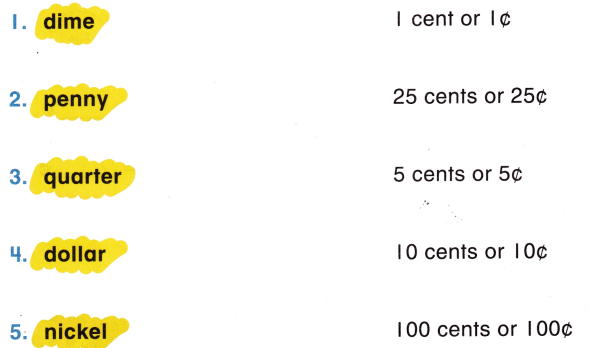
Answer:
1 dime = 10 cents or 10 ¢
1 penny = 1 cent or 1 ¢.
1 Quarter = 25 ¢.
1 dollar = 100 cents or 100 ¢.
1 nickel = 5 cents or 5 ¢.
Explanation:

Concept Check
Count to find the value of the coins.
Question 6.

Answer:
55 ¢.
Explanation:

Question 7.

Answer:
46 ¢.
Explanation:

Count to find the value of the group of coins.
Question 8.

Answer:
80 ¢.
Explanation:

Count to find the value of the coins. Circle the combinations that equal $ 1.00.
Question 9.
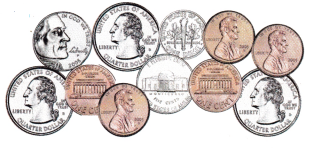
Answer:

Explanation:
In the given figure there are 3 quarters, 3 nickels, 5 pennies.
1 quarter = 25 cents
3 quarters = 3 × 25 = 75 cents
1 nickle = 5 cents
3 nickels = 3 ×5 = 15 cents
1 pennies = 1 cent
5 pennies = 5 cents
Total value of coins = 75 + 15 + 5 = 100 cents.
100 cents = 1 dollar.
Question 10.
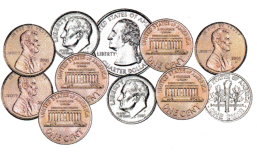
Answer:
The total value of given coins = is 62 cents.
Explanation:
Given,
There are 1 quarter, 3 dimes, 7 pennies
1 quarter = 25 cents
1 dime = 10 cents, 3 dimes = 3 × 10 = 30 cents
1 penny = 1 cent, 7 pennies = 1 × 7 = 7 cents.
Total value of coins = 25 + 30 + 7 = 62 cents.
Use each coin to make one dollar. Write the number of coins you used.
Question 11.

Answer:
The number of coins used in this question are 100 cents.
Explanation:
Given coin is quarter.
1 quarter = 25 cents.
Therefore the number of coins we need to make one dollar is 100 cents.
25 × 4 = 100 cents as 1 dollar is equal to 100 cents.
Question 12.

Answer:
The given coin is Quarter. He needs 100 cents to make 1 dollar.
Explanation:
Given coin is quarter.
1 quarter = 25 cents.
Therefore the number of coins we need to make one dollar is 100 cents.
25 × 4 = 100 cents as 1 dollar is equal to 100 cents.
Problem Solving
Question 13.
Lupe buys a toy dinosaur for 47 ¢. He gives the cashier I quarter and I dime. How much more money does he need to give the cashier?
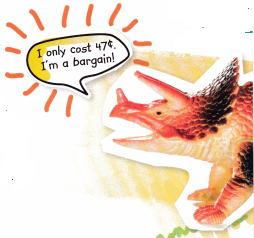
Answer:
He needs 12 ¢ more to give the cashier.
Explanation:
Given,
1 quarter and 1 dime
Lupe buys a toy dinosaur for 47 ¢.
1 quarter = 25 ¢ and 1 dime = 10 ¢.
total value of coins = 25 + 10 = 35 ¢
47 – 35 = 12 ¢
He needs 12 ¢ more to give the cashier.
Circle the three coins Lupe should give the cashier.

Answer:

Question 14.
John has two dimes. Mark has two quarters. How much money do the two boys have in all?
Answer:
70 ¢.
Explanation:
Given,
John has 2 dimes
1 dime = 10 ¢
2 dimes = 20 ¢[
1 quarter = 25 ¢
2 quarter = 50 ¢.
The total money two boys have in all is 20 ¢ + 50 ¢ = 70 ¢.
Test Practice
Question 15.
Lacey found 1 quarter and 1 dime. She already had 30¢. Kyra has 85¢. How much more money does Kyra have?
(A) 10¢
(B) 20¢
(C) 25¢
(D) 30¢
Answer:
Kyra has 20 ¢ more money than Lacey.
Explanation:
Given,
1 quarter and 1 dime
1 = 25 cents and 1 dime = 10 cents
She already has 30¢.
Kyra has 85¢.
Total money Lacey has = 25 + 10 + 30 = 65 ¢.
85 – 65 = 20 ¢.
Therefore Kyra has 20 ¢ more money than Lacey.
Reflect
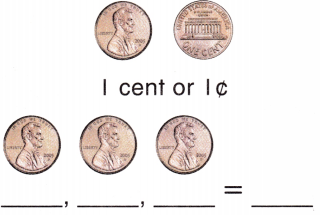
__________ pennies make $ 1.00
Answer:
100 pennies make $ 1.00.
Explanation:

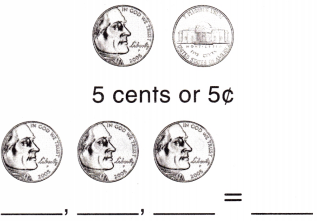
__________ nickels make $ 1.00
Answer:
20 nickels make $1.00.
Explanation:
1 nickel = 5 ¢.
20 nickels = 100 ¢ = $1.00

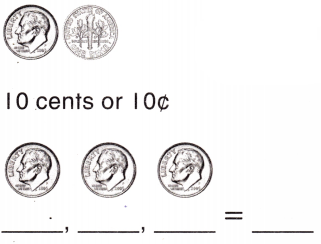
__________ dimes make $ 1.00
Answer:
10 dimes make $1.00
Explanation:
1 dime = 10 cents
10 dimes = 100 cents = 1 dollar.

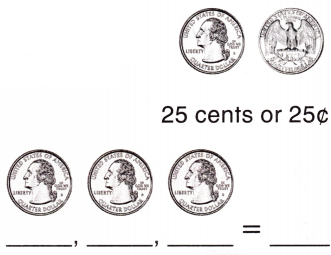
__________ quarters make $ 1.00
Answer:
4 quarters make $1.00.
Explanation:
1 quarter = 25 cents
4 quarters = 100 cents = 1 dollar
